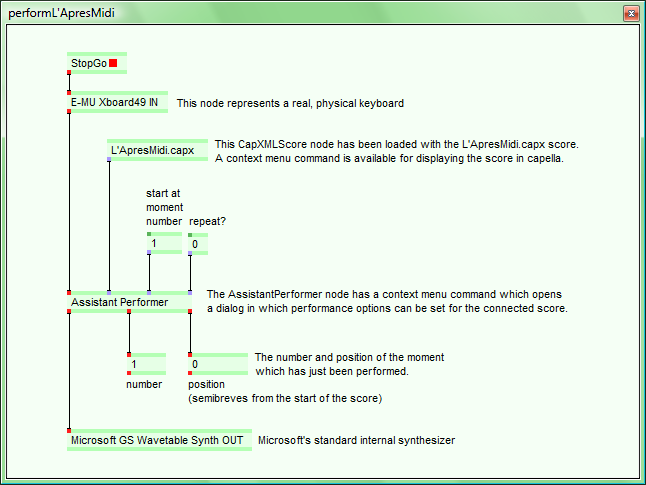Moritz v1
N.B. This page was last changed in October 2010. It has now been archived.Documentation for Moritz v2 can be found at Introduction to Moritz v2.
Introduction to Moritz
Moritz is the framework within which I am developing my work. It has a user interface, designed as a patch editor, but its main purpose is as a convenient testbed for clarifying and pinning down new ideas. The (C#/.NET) software libraries it generates are being used in other, interrelated programs as well.
The following programs currently use Moritz’ software libraries (October 2010):
- Patch Editor (Moritz’ User Interface)
- Assistant Performer*
- Assistant Composer
- Krystals 4.0 (krystals editor)
Moritz was named after Max’s terrible twin (see Max and Moritz): Max specializes in controlling information (sounds) at the MIDI event level and below. Moritz deals with the MIDI event level and above (musical form). MIDI events are the common interface (at the chord symbol level). Among the very first nodes I wrote for Moritz were nodes representing MIDI IN and MIDI OUT devices.
Background
In the early 1980s, I made a real conceptual breakthrough, solving many of the Avant Garde’s problems in music notation, and have been trying very hard to communicate these ideas ever since.But this has proved to be a very difficult process. Unfortunately, it is not enough (even on the web) just to provide good, logical arguments showing that standard music notation is unnecessarily complicated. I need to show that there are unforseen, interesting, concrete, commercially relevant consequences.
So one of the main reasons for creating Moritz is to help me develop these ideas to a point at which they will be more difficult to ignore. With Moritz, I can build on previous work and create some concrete compositions, delivering some proofs of concept along the way. If the proofs fail to convince, I can push on further. Moritz is there to put the screws on. Whatever happens, the results will at least be unique. Maybe I’m just a Romantic Hero after all...
While the sound of these compositions will of course be related to my taste and the tradition in which I grew up, I am also hoping that the concepts will be of more general interest — especially to programmers working in more commercial environments. Nowadays, software is the key to developing any kind of music. For example:
- Defining music symbols purely spatially suggests easier, more powerful ways to write user interfaces for both pre- and post-production music software, such as sequencers, Max, Cubase, Protools etc.
- For me, the simple idea of developing an assistant performer (see below) was closely
related to the insight that music notation is intrinsically timeless. Time is something
in a performer’s brain, something he/she does in the context of an acquired
tradition of performance practice. It is not something absolute, related directly
to the symbols on paper, screen or hard disk.
Avant-Garde composers were unable to solve this (both sociological and technical) problem in the 1950s and 60s, and this failure led to the collapse of written music in 1970.
An assistant performer is something I need as a composer of written new music trying to re-enable the development of specialized performance practices and to wake written music out of its 40-year-old coma.
Here is the standardized patch for Moritz’ Assistant Performer. This allows a single player to perform a score of L'après midi d'un faune in real time. The human performer reads a printed score or plays from memory, the assistant (Moritz) reads and follows the equivalent computer file (L'ApresMidi.capx). This patch is explained in more detail in Mortiz’s Assistant Performer.

Future directions
Moritz’s future is very open. I'd very much like to:- Turn Moritz and the other programs described on this web site into open source, team projects.
- Create scores which can be played in real time in browsers. (I am currently working on the export of scores in SVG format.)